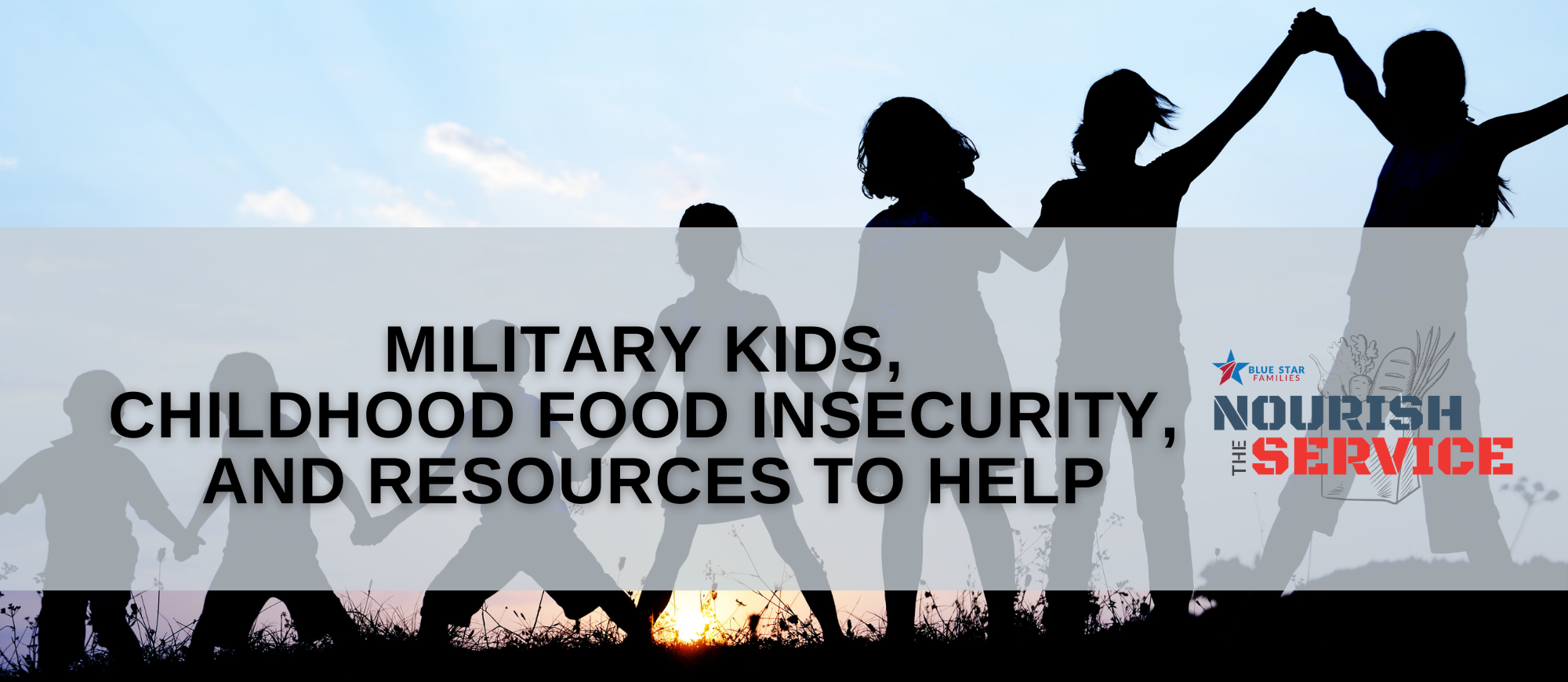Published: April 8, 2022

Military Kids, Childhood Food Insecurity, and Resources to Help
Military children are the highlight of the month of April. When military families serve around the world, military kids serve, too–moving on average every two to three years. These moves can be a challenge, disrupting school, relationships, and ties to their communities. Therefore, it’s no wonder why the official flower of the military child is the dandelion as a dandelion’s seeds can be blown far and wide, always planting roots and blossoming where it lands.
As a military spouse with two “dandelions” of my own, however, I’ve seen firsthand how moves can be met with excitement, anxiety, and sadness all at the same time. For any military family with children, keeping our kids healthy and happy is a priority in this complicated life we have.
Our future force is dependent on the health of today’s military kids.
According to a report from the Department of Defense, the majority of recruits report having at least one family member who has served in the military, and more than 25% of new recruits indicate that they have a parent who served in the U.S. military (Thompson, 2016). However, according to The Military Teen Experience report released by the National Military Family Association (NMFA) in October 2021, 65% of military teen respondents want to serve.
Food insecurity can lead to devastating outcomes for children.
When we discuss food insecurity in military families, we have to assume that military kids are affected. We have known for years that military spouse un- and underemployment directly affects the financial stability of military families, which can be a contributing factor to food insecurity. Furthermore, according to the 2021 Military Family Lifestyle Survey (MFLS), 34% of active-duty spouses who are not currently working but want or need paid employment indicate “child care is too expensive” as a reason they are not working, and 23% of those with children enrolled in K-12 education report that they homeschool or supervise virtual education for their oldest child(ren) (Blue Star Families, 2022). Additionally, in 2020, 20% of active-duty enlisted spouse respondents who are unemployed but need or want to work reported experiencing low or very low food security (Blue Star Families, 2021). Military kids themselves report that they’re struggling. Nearly 36% of teen respondents to NMFA’s 2021 report, The Military Teen Experience, report that they are worried about food running out, 28.41% report that they have sometimes run out of food before, and 7.57% say that this happens often.
Child food insecurity is a health problem because chronic under-nutrition puts stress on cognitive development, changing the neurological architecture of a child’s brain and central nervous system. Food insecure children are sick more often, can suffer growth impairment, and development impairment. Food insecurity also impacts educational outcomes, causing children to do worse in school and struggle with social and behavioral problems. Finally, food insecurity is a workforce and job readiness problem. Children face physical, mental, emotional, and social disadvantages, and threaten the talent, skill, and efficiency of America’s future workforce (Hunger and Health, 2017). The COVID-19 pandemic affected a disproportionate number of Black students, and an alarming number of Black and other children of color were left with inadequate access to school meals. In March and April 2020, the rate of food insecurity for Black households was double that of white households (Held et al., 2021).
When considering the strength of our future force, we cannot afford for today’s military kids to be food insecure!

The importance of school lunch programs:
There are 1.2 million school-age children with military parents in the United States, and nearly 80% attend public schools (Month of the Military Child 2021, 2020). Efforts to improve public school lunches benefit the military kids who attend those schools. Organizations are working to improve the health of school lunches for the 3.2 million kids who attend. Two such organizations include the Chef Ann Foundation – dedicated to promoting whole-ingredient, scratch-cooked lunches, and Brigaid – first aimed to improve school lunches in New London, Connecticut, and has since launched a program in the Bronx. Both organizations have sights set on creating delicious, healthy lunches that kids love.
For Tonya Murphy, Lockheed Martin National Capital Region DEPLOY Fellow and Navy spouse, Brigaid made an enormous impact on her family while they were assigned to Naval Submarine Base New London.
“One thing I loved was that everything was very healthy and balanced,” Tonya recalled. “They were serving kale chips to the kids and the kids loved them and were eating them up. There was a vegetable that was really well prepared. They also gave lots of options, like a hot option, a sandwich option, and a salad option. They were all balanced, so the kids could get what they wanted and would actually eat. The food was prepared in a way that was appealing to all.”
Brigaid doesn’t just serve the children. The program also makes food available to the community.
“Once per month, they would make a culturally relevant meal, with options like Cuban or Dominican, or Puerto Rican foods,” Tonya shared. “It was $5 per plate so the community could come together and have a good, balanced meal at a reasonable cost.”
The school district in New London is considered a racially, culturally, and socio-economically diverse community that is in many ways underserved. For families in the district, they benefit from the free breakfast and lunch programs. Tonya recalled that her children loved breakfasts and lunches because of Brigaid’s work. For residents, the Brigaid program provided a good, nutritious meal with real ingredients.
“My kids actually say that they miss New London because the food at their new school just isn’t the same,” Tonya shared. “Certain recipes and ideas became part of our family meals. We still make ‘school lunch meatloaf’ for dinner, using the recipe from Brigaid.”
Programs offered through Brigaid and the Chef Ann Foundation can be implemented at any school. For example, the Chef Ann Foundation is launching an apprenticeship and fellowship program that includes courses, virtual learning sessions, and on-the-job training to learn how to implement cooked-from-scratch lunches at your school. This could be an incredible opportunity for military spouses in California to improve lunch options at their children’s schools – all while earning an income. Outside of California, military spouses can access the Chef Ann Foundation advocacy toolkit to empower themselves with information to create change in their communities. As a bonus, the Chef Ann Foundation shares healthy recipes for home.
Federal programs to feed the children:
Child Nutrition Programs (CNPs) are available nationwide to offer food and nutrition assistance to children. Military families can also access these programs. Here is an overview of the different CNPs in schools, summer programs, child care centers and homes, and after-school programs:
- National School Lunch Program (NSLP) – a federally-assisted meal program operating in public and nonprofit schools and residential child care institutions that offers free or reduced-price lunches
- School Breakfast Program (SBP) – provides reimbursement to states to operate nonprofit breakfast programs in schools and residential child care institutions
- Special Milk Program (SMP) – provides milk to children in schools and child care institutions that do not participate in other federal meal programs
- Child and Adult Care Food Program (CACFP) – a federal program that provides reimbursements for nutritious meals and snacks to eligible children and adults who are enrolled in care at participating child care centers, daycare homes, and adult daycare centers; CACFP also operates the Afterschool Nutrition Program
- Special Supplemental Nutrition Program for Women, Infants, and Children (WIC) – provides federal grants to states for supplemental foods, health care referrals, and nutrition education for low-income pregnant, breastfeeding, and non-breastfeeding postpartum women, and to infants and children up to age 5 who are found to be at nutritional risk (learn more about WIC from last month’s Nourish the Service blog post)
- Summer Food Service Program (SFSP) – a federally-funded, state-administered program; SFSP reimburses program operators who serve free healthy meals and snacks to children and teens in low-income areas
- Pandemic Electronic Benefit Transfer (P-EBT) – part of the government response to the COVID-19 pandemic; several states have been approved to operate a Pandemic EBT program during the 2021-22 school year, so benefits may still be available
If you have questions or would like to see if your family can qualify for assistance, visit this contact map, click on your state, and follow the link to the program that you’re interested in learning more about.
As we celebrate our resilient military-connected children this month and beyond, let us not forget to also advocate for the children who are in food insecure homes. Military children sacrifice so much already. They shouldn’t also have to sacrifice nutrition.
Thank you to Amazon and Craig Newmark Philanthropies for sponsoring Blue Star Families’ Food Insecurity DEPLOY Fellowship!
References
Children and Families – Hunger and Health. (2017, January 12). Hunger and Health. Retrieved March 18, 2022, from https://hungerandhealth.feedingamerica.org/explore-our-work/programs-target-populations/children-and-families/
Held, L., Fantom, L., Lappé, A., Nargi, L., Wallace, H., & Holt, S. (2021, January 26). The pandemic reveals racial gaps in school meal access. Civil Eats. Retrieved March 20, 2022, from https://civileats.com/2021/01/26/did-pandemic-disruptions-to-school-meal-programs-leave-out-students-of-color/
The Military Teen Experience. (n.d.). National Military Family Association. Retrieved March 17, 2022, from https://www.militaryfamily.org/the-military-teen-experience/
Month of the Military Child 2021. (2020, November 30). MilitaryBenefits.info. Retrieved March 18, 2022, from https://militarybenefits.info/month-of-the-military-child/
Thompson, M. (2016, March 10). Here’s Why the U.S. Military Is a Family Business. Time. Retrieved March 17, 2022, from https://time.com/4254696/military-family-business/
2021 Military Family Lifestyle Survey Comprehensive Report. (2022, March). Blue Star Families. Retrieved March 18, 2022, from https://bluestarfam.org/wp-content/uploads/2022/03/BSF_MFLS_Results2021_Spouse-Employment-and-Child-Care_03_10.pdf
Posted In: Food Insecurity

